The Evolution of Underfloor Heating Systems from the Roman Period to the Present
A Comfort Beyond Time: The Past and Future of Underfloor Heating
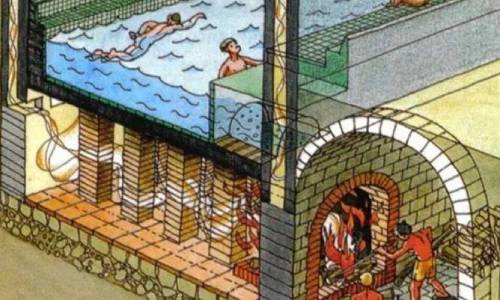
Underfloor heating systems have been used for thousands of years to keep homes warm, healthy, and comfortable. In this article, we will be examining the birth of underfloor heating systems and its evolution from the Ancient Roman times to the present day. We will also discuss how engineers have made our lives more comfortable with innovations in underfloor heating technology.
Advanced Technology of Ancient Rome: Underfloor Heating Systems
Have you ever walked into a room or stepped out of the shower and felt warmth in your feet? If your answer is yes, we can say that we owe this luxurious comfort to the Romans. Who would have guessed that people who are fond of comfort would inspire even centuries later and pioneer the system that is so used and developed today?
What is a hypocaust?
Hypocaust was considered to be the ancestor of the floor heating systems used today, and was used in the baths of Ancient Rome and later in the homes of some wealthy families. At first, it was used in public baths, and during the imperial period, it spread rapidly in almost all provinces and found a wide range of uses.
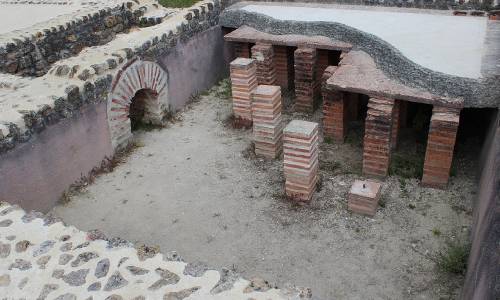
What is the working system of the Hypocaust?
Roman architects and writers working on the hypocaust in this period made long mathematical calculations on issues such as room temperature, the amount of wood to be burned, the permanence of heat on the bath and the environment. Assuming that the furnace would burn continuously throughout the year, they calculated the annual wood consumption as 114 tonnes.
As you can imagine, a wood consumption of 114 tonnes was quite high in that time. The time and effort spent for collecting these trees was also a highly time-consuming work in that time. Especially in winter days when the temperature was low, reaching the desired indoor temperature has increased this consumption even more. In order to meet this energy, there was a large amount of tree massacre.
How is Temperature Transfer Provided?
The flue gases which is providing heating to the room, was called “Pilae”. These supports were arranged in rows on the floor. These supports made of bricks were combined with mortar and placed on the floor of the bath. This floor is designed in an inclined shape. This helped to avoid any problems that might arise such as fire. It also made it easier to clean the ashes.
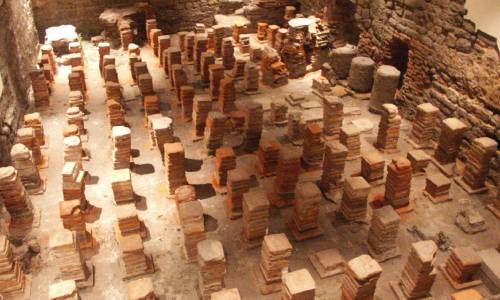
In the graph below, you can see the drop in surface temperature across the room. The drop in temperature is due to factors such as the flue gases that lose their temperature throughout the room, the size of the room, and the temperature of the external environment.
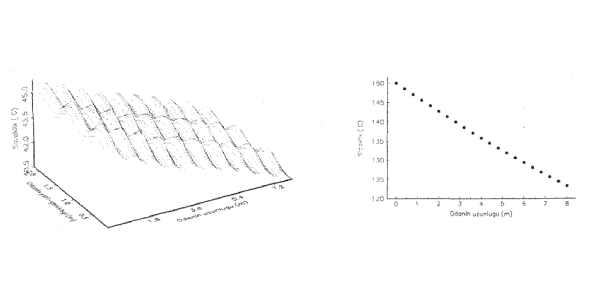
As you can imagine, the hypocaust system was very dangerous. One of these was the poisoning of people by carbon monoxide gas resulting from burning.
It is also known that many people died due to gases leaking from the supports called pilae. In addition, situations where the burning fire got out of control and caused a fire were also frequently encountered at that time.
This heating technique, which was used for about 1000 years, also inspired the heating of the baths in the Andalusian region. Today, we can still come across the remains of hypocausts in many ancient cities in Anatolia and the Mediterranean area.
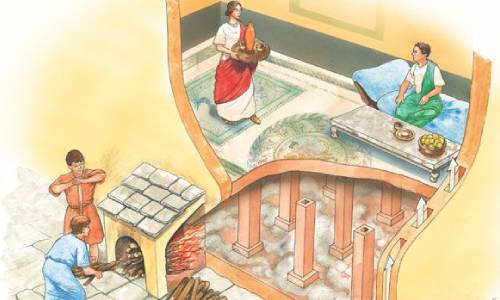
In particular, the Roman Bath of Ankara is one of the most important examples of hypocausts from the Roman times, which is still widely visited today.
Although we admire this unique, innovative and creative system that the Romans brought to the world, the hypocaust system has already taken its place in history. Of course, their contribution to the floor heating systems we use today and the vision they brought to the world is priceless. However, the energy problems of our age and our diminishing resources have always led us to the feeling of finding new solutions. For this reason, we have turned to floor heating systems that are less dangerous, environmentally friendly, more efficient and more functional. These systems have had a very widespread use in the world.
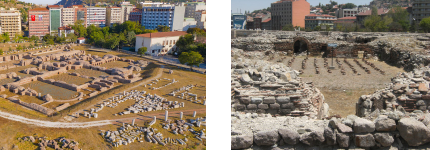
With the development of science and technology, now we have the opportunity to give due importance to nature, save energy and heat efficiently. In our developing and transforming world, the ideas of protecting nature and using energy in a controlled way have become a responsibility that no one can say no to.
A Comfort Beyond Time: Underfloor Heating Systems Today
Over the past century, we have evolved from simple underfloor heating systems to systems that can provide personalised heating in any room of the house. With this evolution, underfloor heating systems have become more diverse and have opened up many areas of use. In particular, it has made great contributions to preventing the waste of energy, money and time that has emerged over the years.
Let’s take a look at how these systems have evolved to the present day in order to use energy resources efficiently and effectively.
KasTherm – Underfloor Heating Systems in Turkey
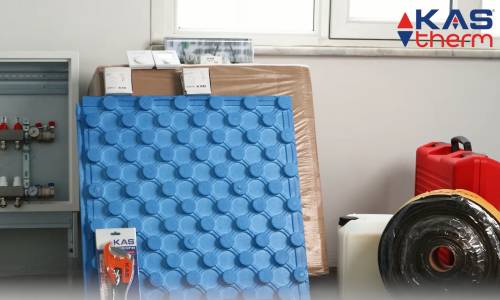
So what has changed in this system from centuries ago to the present day? What are the differences between the heating systems in Roman times and KasTherm floor heating systems that are currently used in our homes, workplaces and many other areas?
Same logic, but different working system
As in Roman times, Kastherm underfloor heating systems spread the heat through the floor into the room. But you no longer need to burn wood for these systems to work 🙂 Instead, Kastherm collectors perform this task for you and even control the temperature in your home up to the degree of heat thanks to digital room thermostats. In addition, the heat gained lasts much longer in the room.
What is the Working Logic of KasTherm Floor Heating Systems?
- The water coming from the energy source such as boiler or combi boiler reaches the collectors with pipes.
- Water is distributed to the pipes through the collector mounted on the wall.
- The water reaches the pipes placed on the floor and the heat begins to spread in the room.
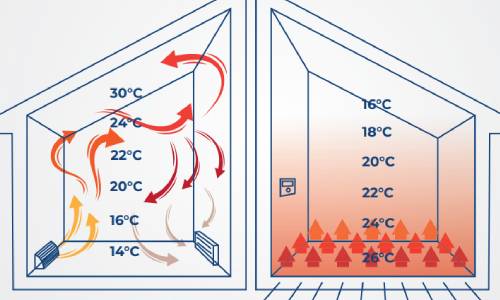
Where can Kastherm Underfloor Heating Systems be used?
- Home Offices
- Sunrooms
- Bedrooms
- Kitchens
- Basements
- Garages
- Bathrooms
- Schools

What Advantages Do KasTherm Underfloor Heating Systems Provide?
What are underfloor heating benefits?
1) Health and Hygiene
Underfloor heating system due to its functioning at a lower temperature:
- Reduces the circulation of pollutants in the air.
- Does not cause dusting.
- It does not dry out the humidity of the environment and thus reduces health problems caused by excessively dry air.
2) Savings
- It saves 15% compared to traditional heating systems.
- Since it works at low temperatures, it saves fuel.
- While Radiator Systems work with 70-80 °C hot water, the floor heating system operates at 30-50 °C.
3) Long Life
- It lasts 3 times longer than traditional heating methods.
4) Efficient Heating
- In the radiator system, the heated air goes to the upper part of the ceiling first. It loses its heat significantly until it completes its circulation and reaches the floor. The feature of KasTherm heating systems is to ensure homogenous distribution of heat. The heated air rises in the room and the environment is heated.
Why KasTherm?
The feature of the KasTherm heating system is to ensure that the heat is distributed homogeneously in the room. Starting from the floor, the heated air rises homogeneously in the room and the environment is heated more efficiently. In KasTherm, This system allows to use the heat in the environment more functionally. KasTherm also works with high performance as it is a system that significantly prevents heat loss.
With the advancement of science and progress in technical development, floor heating systems have become more diverse. Modern underfloor heating systems are easy to install and can easily raise the temperature in new buildings, thus allowing people to spend less time, money, energy to heat their homes on a cold winter day.
How the KasTherm underfloor heating systems work?
Basically, the heat of hot water from the energy source is spread over the surface through pipe tubes. And pipe tubes heats the environment.
How do you choose the best underfloor heating system for your home?
The quality of the materials to be used, plays an important role at this point. At the same time, the material to be used should be calculated according to the size of the room you want to heat in your home.
Why are some areas on the floor of the house warmer?
Underfloor heating systems can be applied to any area in your home. For example, it may be available in your bathroom but not in the living room.
How can I increase the effectiveness of the heating system in my home?
Switching from traditional radiator heating systems to underfloor heating systems may be a solution for you. It’s not only increases the effective distribution of heat in your home, but also saves energy and money for you.
How to Install Kastherm Underfloor Heating System?
From the link below, you can watch the installation of the underfloor heating system from start to finish.
https://www.youtube.com/watch?v=S23p37uts00
How long does it take to heat up?
It heats up in an average of 2-4 hours.
In which parts of my house can I use underfloor heating systems?
You can use underfloor heating systems in every area of your home. The most commonly used area of underfloor heating systems is the bathroom. and living room.
Will there be leakage from the pipes?
Kas uses KasTherm pert pipes in underfloor heating systems. Pert pipes are produced in 3, 5 layers and are resistant to impacts. Thanks to its flexible structure, there is no problem such as tearing or breaking and it is resistant to high temperatures. Thanks to these features, there is no water leakage from KasTherm pert pipes.
On which surfaces can underfloor heating systems be used?
Underfloor heating systems can be easily used on stone or tile floors, wooden floors and many floor types.
KAS has been making your life easier since 1970 with its sanitary and heating systems products produced with quality and expert workmanship. On all the issues you want to consult; You can send an e-mail to info@kas.com.tr or call 0 216 311 35 45 for information.

 English
English